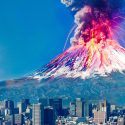No more vast, barren deserts. Because we are going to turn them all into lush, green farmlands. How would we go about bringing new life to hot deserts? How much would this transformation cost? And how could this greenifying destroy the Amazon rainforest?
With the global population growing and a decrease in healthy land to farm on, now is the time to create new agricultural technologies. Deserts cover one-third of all the land on Earth. They are the driest ecosystems on the planet, with each receiving less than 25 cm (10 in) of rain every year.
So maybe it’s time we turned these barren lands into something more useful. But could transforming an entire ecosystem create an even bigger climate crisis? Growing anything in these sands is tough because some deserts can lose up to 33 times more water than they receive. This happens through the processes of evaporation and transpiration. Or as they are known together, evapotranspiration.
If you wanted to transform deserts into farmland, you’d need to help the land retain more water. One method could be a revolutionary way of mixing very small amounts of clay into the soil. Nanoclay is extremely tiny particles of clay 500 times smaller than a single strand of hair. If a layer of this clay surrounded each particle of sand, it would allow water and nutrients to stick.
In the United Arab Emirates, tests found that this process reduced water usage by 47%. In just 40 days, a barren plot of sand was able to grow watermelons. And the only two components you need are water and clay. Two things that farmers have been adding to soil for thousands of years. But it wouldn’t be so simple for you. Working with thick clay would be extremely labor-intensive.
You could also disrupt underground ecosystems by releasing large amounts of CO2 or even creating a waterproof seal over the surface. If you added this liquid nanoclay into water irrigation systems like sprinklers, then it could make its way down to the roots. If successful, the desert sands would now retain more water. From that, the entire desert could be transformed into high-yield, healthy soil.
Here’s the thing. You’d need a lot of clay. And even more water. If you aimed to terraform all deserts on Earth, that would be about 6.7 quadrillion L (1.7 quadrillion gal) of water. That’s nearly half the water volume of Lake Superior, the largest of North America’s Great Lakes. Could your budget handle a bill for $336 trillion? That’s what spraying every single desert would cost.
That’s four times the GDP of the world. Oh, and did I mention you’d have to repeat this every five years? On a positive note, you’d now be able to grow a lot more food and transform life on farms and villages located around deserts. No more sand or dust storms shutting down roads and railways. On a bad note, we might just lose the entire Amazon rainforest. Let me explain.
The Amazon acts as a carbon sink. It absorbs carbon dioxide and by doing so it helps fight off climate change. It also releases much-needed oxygen. Now, how is the Amazon connected to greenifying deserts? Well, the sand from the largest hot desert on Earth, the Sahara, gets picked up by winds and crosses the Atlantic Ocean all the way to South America.
On its way to the Amazon, the dust particles pick up moisture. Then, they fall over the Amazon in the form of rain. And that sand and water combo also works as a fertilizer. Turning deserts green would disturb this fertilization process to the point we could lose the Amazon rainforest forever. This would be bad news for the climate thanks to the disruption to Earth’s natural balance.
All the plants we’d grow on newly terraformed land might not be enough to prevent the crisis. Not just in the Amazon, but across the entire planet. Liquid nanoclay is just one idea to help bring sustainable agricultural growth to the planet’s most extreme environments, but every step forward in one location can come at a cost to somewhere else.
Sources
- “Nanoclay: The Liquid Turning Desert To Farmland”. Rachel Lovell. 2022. bbc.com.
- “What Percentage Of The Earth’s Land Surface Is Desert?”. Fraser Cain. 2010. universetoday.com.
- “Transforming Deserts Into Fertile Farmland Using Liquid Nanoclay”. 2022. climatecolab.org.
- “Largest Countries In The World By Area”. 2022. worldometers.info.
- “Saharan Dust Feeds Amazon’s Plants”. 2015. nasa.gov.



























